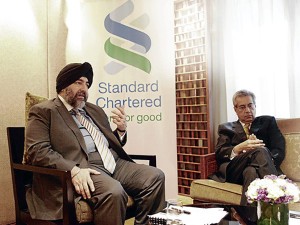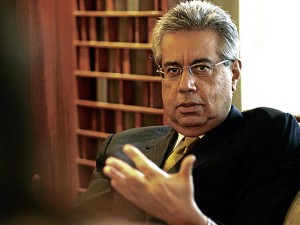Standard Chartered plans to stay in PH for good
British bank Standard Chartered, the longest serving foreign bank in the Philippines, has done business in the country through World Wars, economic cycles and political upheavals over the last 140 years.
It has been around to serve key people in history like national hero Jose Rizal, who used its banking services when he was a student in Europe.
Top bank officials believe that more than ever, the Philippines today has the potential to enter a new growth phase.
And after over a century of being here, Stanchart is keen on remaining an integral part of the Philippine growth story.
“What’s different for the Philippines now is the renewed sense of confidence that the political climate is stable, that the current administration has the right intents and desires and I think fiscal position of Philippines is very strong and the balance sheet is very strong,” Stanchart Philippines chief executive officer Mahendra Gursahani says in an interview with Inquirer.
High growth period
“The conditions internally all point to a period where if the execution is in the manner that the government intends, then we should see a period of growth that is perhaps unprecedented,” he adds.
Mahendra says business process outsourcing and remittances would continue to help the Philippine economy grow while other new growth drivers like tourism may become more significant in the future.
He notes that the entertainment city being developed by the government through the Philippine Amusement and Gaming Corp. is part of this effort to boost tourism. “Mining obviously remains to be one that has a huge potential but it also fraught with challenges,” he says.
The fact that Stanchart was the first international bank to set up shop in the Philippines is already a proud legacy, Mahendra says, adding that the bank will continue to be part of future growth.
“We’ve seen the country go through much in those 140 years and the fact that we’ve remained here with an unbroken stint is a testimony to our commitment and confidence in the Philippines and our role in the economy, which over the years, in different shapes and forms that have evolved with the economy as a whole,” he says.
At ease in Asia
Overall, Stanchart is at ease doing business in Asia, which now accounts for two-thirds of its global franchise whether by revenues, profit, assets, staff headcount or bank branches.
“It’s primarily our home,” says Stanchart Asia CEO Jaspal Bindra, who recently flew in to grace the bank’s 140th anniversary celebration gala night.
Jaspal says Southeast Asia, the region where the Philippines is part of, is doing exceptionally well.
”It’s one of the fastest growing regions within the bank and the more positive feature of that growth is that a lot of growth is happening intra-Asean which is even better,” he says, noting the strong domestic consumer markets in the region.
Compared to other regional groups, Jaspal says the bank’s business in the region is also growing much faster because “we don’t have some of drags” that the economies are experiencing in Europe or Japan.
“But when it comes to domestic local banks, then clearly they are doing as well as we are,” he says.
Stanchart has been doing business in Asia for 154 years, its first two markets being China and India or long before these two became the world’s fastest-growing economies. The bank is now present in 19 countries in Asia.
In the Philippines, Stanchart is operating at its full capacity of six branches, the maximum number allowed by the Bangko Sentral ng Pilipinas. It employs close to 500 people domestically but overseas, about 400 Filipinos are employed in its international network.
Mahendra says this is already an “impressive number” but the bank would like to see this number grow even further.
“Our intent will be to use the Philippines as a good training laboratory, where we can get good talent here, with a view to getting them to contribute to our agenda in the Philippines but also with an eye to creating an international career,” Mahendra says.
Long before offshoring and outsourcing became a trend among global institutions and long before the Philippine emerged as a competitive hub for business process outsourcing, Stanchart already set a BPO hub in India.
But the bank isn’t closing its doors to a potential investment in Philippine BPO in the future as it grows its global business.
Competing onshore
Stanchart was among the first four foreign banks to set operations in the country but in the mid-1990s, the government liberalized the banking system to allow 10 more foreign banks to set up branches.
Given foreign banks’ limited distribution channels, they usually focus on wholesale banking, credit card lending (for consumers) and private banking services to high net worth clients. Some competitors, however, have also gone deeper into the retail market through the acquisition of savings bank subsidiaries.
“Competition is not something that’s new to us. We compete in all our local markets. It’s not a reason for us to either withdraw or feel that we’re compromising our position in any way. It has created new ways to contribute and create competitive edge and we have many, being an international bank that’s focused on Asia,” Mahendra says.
Being in this market longer than other foreign players and utilizing the expertise and capacity of its hubs in Singapore and Hong Kong, Mahendra says the bank continues to offer an array of products and solutions that add value to its customers and to the Philippine economic agenda.
From transaction banking to corporate finance to corporate advisory work as well as private and public sector capital market transactions, Mahendra says Stanchart is participating in a variety of initiatives.
While its consumer business is limited by its franchise, Stanchart still participates in most lending products and beefed up its wealth management business a few years ago.
The bank has also resolved to contribute to the Philippines’ public-private partnership (PPP) projects.
“We will participate in those in the way that we can bring value not always as a direct participant of funding, but by introducing our clients who are entrenched in Asia. Many of our clients will be interested in participating in the Philippines,” Mahendra says.
140th celebration
To mark its 140th year in the Philippines, the bank wanted to do something meaningful.
Thus during the gala night on March 26, Jaspal announced a $1-million donation to the cause of eliminating curable blindness through a partnership with CBM/Cataract Foundation of the Philippines.
This is part of the bank’s global “Seeing Is Believing” project launched in 2003, which has since raised a total of $40 million to restore the eyesight of 2.5 million people around the world.
“It’s a cause that our staff, clients and partners participate in,” Mahendra says.
The bank’s ambition is to raise a total of $100 million by 2020. Under the program, Stanchart matches $1 for every $1 contributed and it ties up with non-government institutions and charities around the world to implement the program.
Likewise in line with the “Seeing is Believing” theme, the bank will launch a photography competition open to professionals and amateurs. “It lends to the vision for vision theme and also allows the community to participate and hopefully for us, create great photographs of Philippine landscapes,” Mahendra says, adding that details of this competition is still being finalized.
What’s in store after 140 years?
“Even through civil wars, World Wars or other kinds of social unrest or upheavals in some nations, we continue to service our banking clients. We don’t get scared easily and we remain true to our commitment to service. This is the essence of our brand promise to be here for good,” Mahendra says.
















